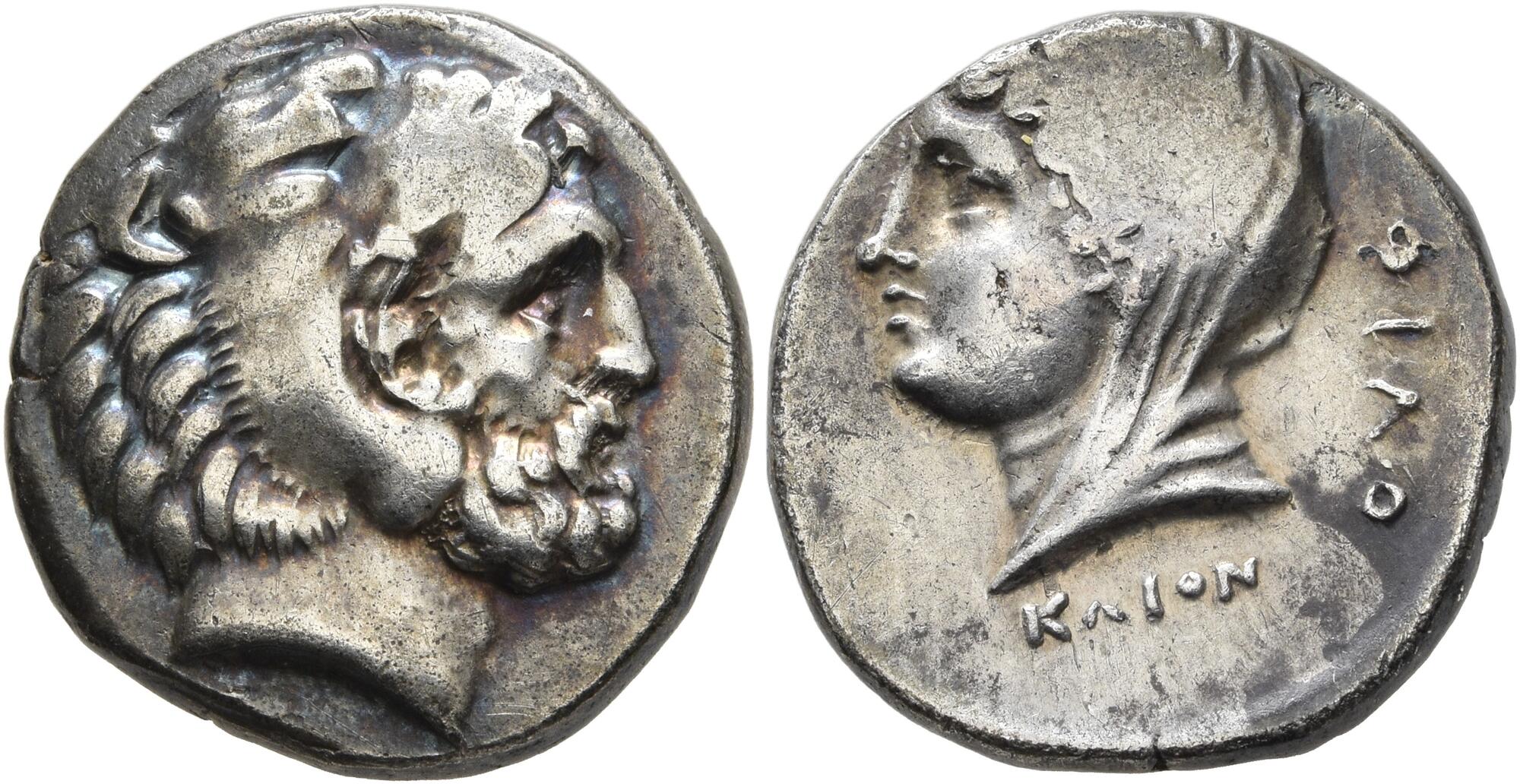Cos, silver, didrachms (Heracles/veiled female head) (365-355 BCE) Meadows
From SILVER
365 BCE - 355 BCE Silver 656 kg
Description
| ObverseInscription or printing placed on the obverse.: | Bearded head of Herakles to right, wearing lion skin headdress |
| ReverseInscription or printing placed on the reverse.: | ΦΙΛΟ / KΩION (Greek).Veiled head of Demeter to left |
Mint and issuing power
| MintIdentifies the place of manufacture or issue of a numismatic object.: | Cos | Ancient regionAncient region.: | Caria (islands) | Modern countryModern country: Greece | AuthorityIdentifies the issuing power. The authority can be "pretended" when the name or the portrait of X is on the coin but he/she was not the issuing power. It can also be "uncertain" when there is no mention of X on the coin but he/she was the issuing power according to the historical sources: |
Chronology
| FromIdentifies the initial date in a range assigned in a numismatic context. | 365 BCE | toIdentifies the final date in a range assigned in a numismatic context.. | 355 BCE | PeriodTime period of the numismatic object.: Classical 480-323 BC |
Physical description
| MetalThe physical material (usually metal) from which an object is made.: | Silver |
Median weightMedian of the weights of numismatic objects (in grams). in grams | 6.80 | DenominationTerm indicating the value of a numismatic object. Examples: tetradrachm, chalkous, denarius.: | didrachm |
StandardStandard.: |
Image

S1969 Cos didrachms veiled head Meadows.jpg [1]
References
| Die study referencePublication of the study: | Ashton et al. 20021Ashton et al. 2002, p. 233-236 | ||
| Coin series referenceReference to coin series study: | Sear II2Sear II, n° 4988, HGC 63HGC 6, n° 1304-1306, Stefanaki 20124Stefanaki 2012, p. 209-217, n° 537-711 (6.13) | ||
| Coin series web referenceCoin series web references: | |||
Obverse dies distribution
| FrequencyFrequency of specimen in distribution. ᵖ | Number of obversesNumber of obverse dies. ᵖ (o) | % (o) | Number of coinsNumber of coins. (n) | % (n) | Die nameName(s) of the die(s). |
| 16 | 1 | 20 | 16 | 12.03 | 1 |
| 19 | 1 | 20 | 19 | 14.29 | 4 |
| 20 | 1 | 20 | 20 | 15.04 | 5 |
| 29 | 1 | 20 | 29 | 21.8 | 3 |
| 49 | 1 | 20 | 49 | 36.84 | 2 |
| Total | 5 of 5 | 100 | 133 of 133 | 100 |
Reverse dies distribution
no distribution is available
Quantification
| Number of obversesNumber of obverse dies. ᵖ (o) | 5 | Number of singletons (o1)The number of singleton coins. ᵖ | 0 |
| Number of reverse diesNumber of reverse dies. (r) | 24 | Number of coinsNumber of coins. (n) | 133 |
| Coins per obverse dieNumber of coins per obverse die. (n/o) | 26.6 | Coins per reverse dieNumber of coins per reverse die. (n/r) | 5.54 |
| Reverse per obverse ratioRatio of obverse dies divided by reverse dies. (r/o) | 4.8 | Percentage of singletons (o1)number of coins (n) divided by the number of singletons (o1) ᵖ | 0 % |
| Original number of dies (O) (Carter 1983 formula)The estimation of the number of coins according to Carter 1983 ᵖ | 4.82 | Coins struck if 20,000 as average productivity per dieCoins made if the average productivity for obverses (according to Carter) is 20,000. ᵖ | 96,400 |
| Original number of dies (O) (Esty 2011 formula)The estimation of the number of coins according to the singleton formula in Esty 2011 ᵖ (O) | 5.2 | Survival rate if 20,000 as average productivity per dieSurvival rate if average productivity is 20,000. ᵖ | 0.00138 |
| Coverage (o = % of O) (Esty 1984 formula)Esty 1984 - coverage (% of O) ᵖ (o = % of O) | 100% | Die productivity if survival rate 1/2,000Average productivity if survival rate is 1/2,000. ᵖ | 55,186.72 |
| Weight of silver (in kg) if 20,000 coins per die (O = Carter formula)Carter 1983 * Median weight * 20000 (*10 if gold or electrum) ᵖ | 656 kg <br /> 656 kg | Die productivity if survival rate 1/5,000Average productivity if survival rate is 1/5,000. ᵖ | 137,966.8 |
Remarks
Most likely two workstations
References
- ^ Ashton, Richard - Hardwick, Nicholas - Kinns, Philip - Konuk, Koray - Meadows, Andrew (2002), "The Pixodarus Hoard (CH 9.421)", Coin Hoards, IX, RNS Spec. Publ. 35, London, p. 159-243.
- ^ Sear, David R. (1979), Greek coins and their values. Vol. II, Asia and North Africa, London, xlviii, p. 317-762
- ^ Hoover, Oliver D. (2010), The Handbook of Greek Coinage Series, volume 6 : handbook of coins of the islands: Adriatic, Iionian, Thracian, Aegean, and Carpathian seas (excluding Crete and Cyprus), sixth to first centuries BC, Lancaster, 358 p.
- ^ Stefanaki, Vassiliki E. (2012), Nomismata. Nomismatike Aigaiou : Kos I, Athens, 531 p.